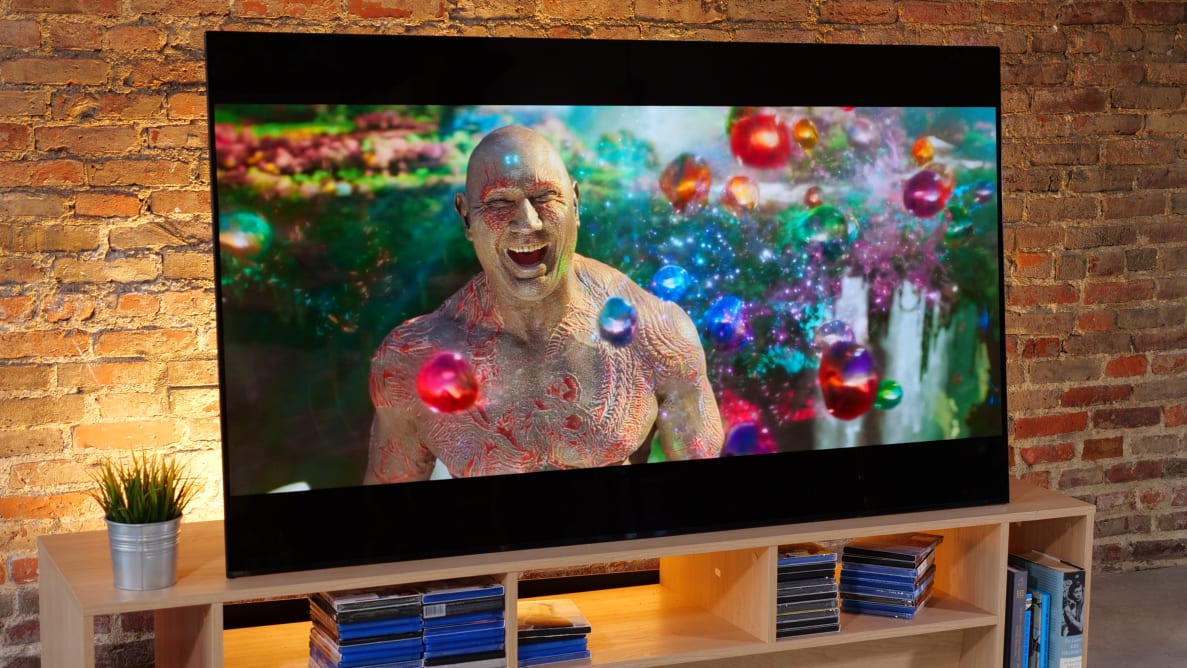Pros
-
Amazing contrast
-
Unique design
Cons
-
Software is a bit of a headache
OLED TVs are doing kind of a funny thing right now: They're simultaneously coming down in price, making them accessible to people who, until now, haven't had the means to consider them an option, and they're starting to feel the heat from less-premium 4K TVs, which are getting better with each passing year. Basically, the more affordable OLED TVs become, the better (and more affordable) their non-OLED competitors seem to get.
But that doesn't change the fact that there's never been a better time to buy an OLED. Our top-rated TV is currently the 2018 LG C8, which, believe it or not, is also LG's most affordable OLED offering coming into 2019.
In order to go toe-to-toe with its direct OLED competitors (as well as budget-friendly, big-screen non-OLED HDR sets), Sony's A9F Master Series needs to set itself apart from the pack. And, for the most part, it succeeds—the A9F is a visually striking, top-tier television with the HDR chops to nip at LG's heels. What it doesn't do, however, is justify its price point for anyone outside of a very slim niche.
About the Sony A9F Master Series OLED TV
The A9F Master Series is available in two sizes: big and really freakin' big. Our loan unit is the really freakin' big 65-inch model, but there's a leaner, 55-inch version of the A9F, too.
• 55-inch (Sony XBR55A9F), MSRP $3,499.99 • 65-inch (Sony XBR65A9F), MSRP $4,499.99
We have no reason to suspect that there'd be any major differences in performance based on model size, especially given the self-illuminating nature of OLED panels. In terms of the basics, here's what you can expect from the A9F, regardless of which size you opt to buy:
• 4K resolution (3,840 x 2,160) • High Dynamic Range compatibility (HDR10 and Dolby Vision) • Built-in smart platform (Android) • Native 120 Hz refresh rate
Before we test each TV, we keep the panel running with a continuous signal for at least 24 hours, which gives the pixels time to warm up. All of the tests were done with the A9F's "Cinema" picture setting, but out of the box, the default input is set to "Vivid."
I'll dive into some of these results further down the page, but here are some key takeaways from the A9F's time in our test labs.
Performance Data (Cinema mode, ANSI checkerboard pattern)
• HDR contrast (brightness/black level): 308.1 nits/0.002 nits • SDR contrast (brightness/black level): 243.2 nits/0.002 nits • HDR peak brightness: 729.8 nits (10%)
• HDR color gamut coverage: 98% (DCI-P3/10-bit) • SDR color gamut coverage: 100% (Rec.709)
• Viewing angle: ±99.3°
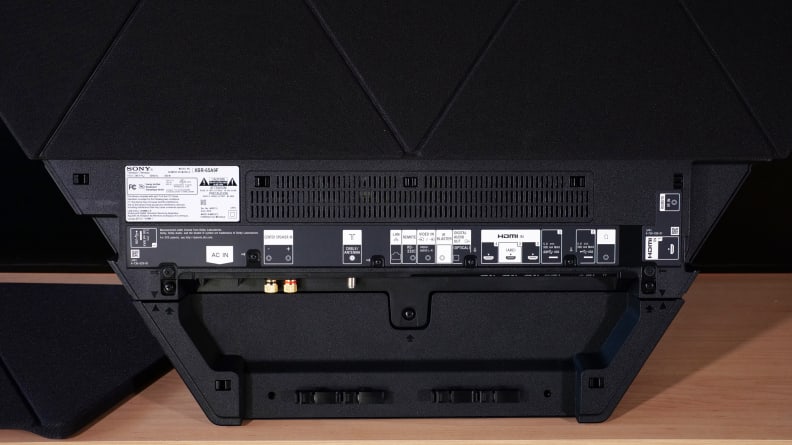
You'll find no shortage of connectivity options on the back of the A9F—and cord slots for neat and tidy cable management.
Connectivity
• 4x HDMI 2.0 (1x ARC) • 3x USB • Component, LAN Ethernet, RF input
What We Like
From a design standpoint, the A9F is somewhat of a triumph
As an object, the A9F is visually striking; it's a slightly tilted slab that appears to stand on its own without the aid of a typical TV stand. Instead of a typical base stand, the A9F is affixed with a heavy lean-to that allows the panel to rest upright on a surface, anchored in place. From behind, the setup looks like an upside-down chip clip.
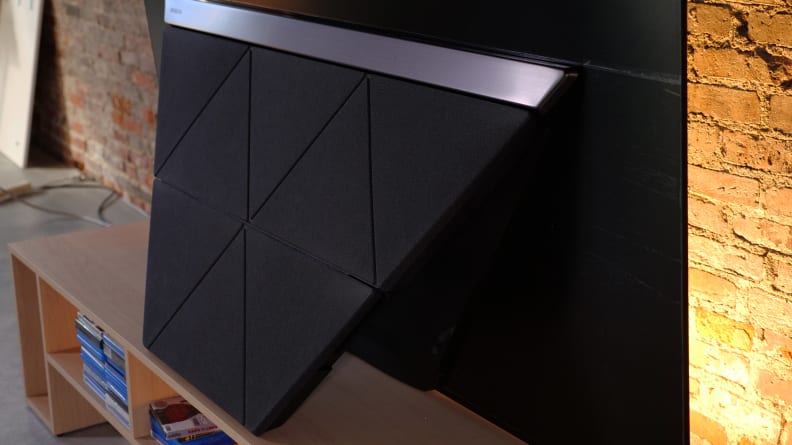
The stand is elegant from the side (especially with its ports obscured by the clip-on cover), but it gives the panel a natural tilt that some users might not be comfortable with.
The TV's various connectivity options are built into this back piece, and there's a sleek, soft-textured cover that hides all of the components. This design doesn't just look elegant, it also manages the A9F's cable situation.
There are aspects of the Master Series' design that don't go down easy, however—but more on that later.
The stunning contrast we've come to expect from OLED TVs
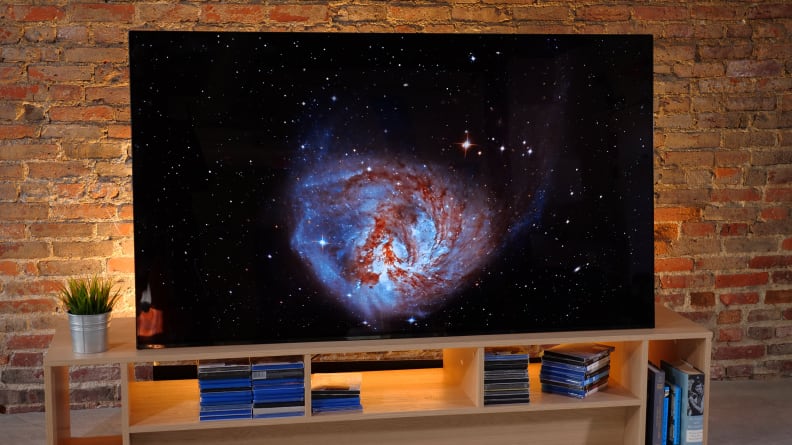
Because the pixels found in OLED displays are self-illuminating, the space in between stars is free to get as dark as possible.
The benefit of OLED panels is that each individual pixel turns on and off independently of one another and without the aid of a back light or an edge light. This allows for deeper, richer black levels, and superb overall contrast.
As an example, consider a movie or TV show's depiction of a starry night: While traditional edge-lit panels need to flood the entire night sky with dim light in order to produce each twinkling dot, an OLED panel renders each star with pinpoints of bright, concentrated light consisting of a few self-illuminated pixels. The surrounding night sky, therefore, is free to be as inky-black as the content creator's originally intended.
It all comes down to contrast—the cornerstone of a display's overall performance. And OLED TVs do contrast better than anything else on the market today.
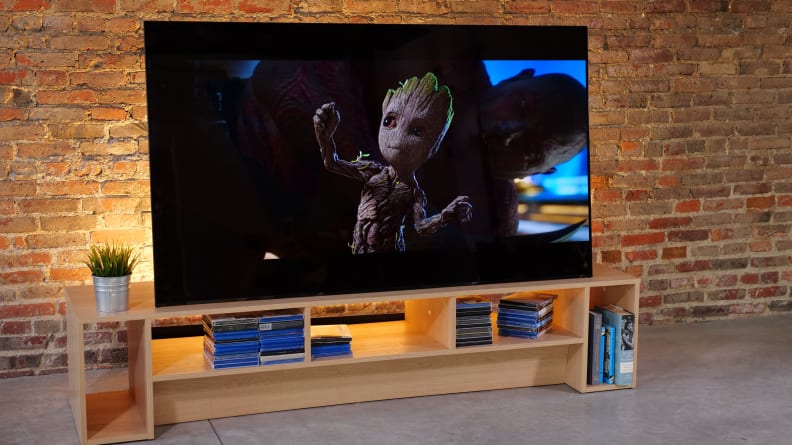
HDR and Dolby Vision content shines on the A9F. The OLED panel doesn't get quite as bright as some of its non-OLED competitors, but the TV's deep black levels make up for the lack of truly searing highlights.
The A9F is capable not only of deep, dark shadows, but also produces some pretty dazzling light shows, too. To be clear, the A9F isn't quite as bright as some of the backlight-powered, non-OLED competitors it shares floorspace with at Best Buy (the Samsung Q9FN, for example, is capable of producing searing highlights well over 1,000 nits), but the bottomless black levels go a long way in evening the playing field.
HDR performance near the top of its class
Although pretty much all HD content looks good on an OLED TV, top-shelf TVs like the A9F are measured mostly by how well they render the best-looking commercially available content—in this case, that's content mastered in HDR. The A9F supports both HDR10 and Dolby Vision content (the two current HDR formats) and whether you're playing it directly from a 4K Blu-ray or streaming it directly from platforms like Amazon or Netflix, it looks really, really good.
The extra oomph in brightness benefits mostly from the panel's void-like black levels, so even though the A9F won't be blinding anyone with blazing pops of light like the Vizio P-Series Quantum, the overall level of detail present as a result of the A9F's dizzying contrast ratio more than makes up for it. In fact, the A9F is more than capable of commanding attention even in a brightly lit room.
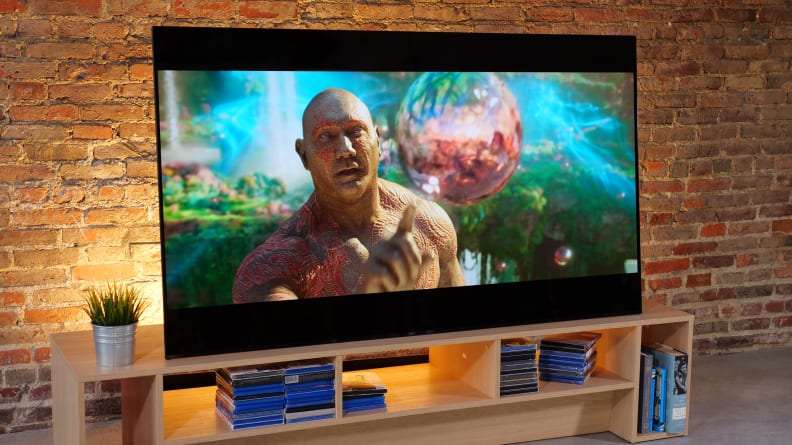
The A9F produces brilliant, well-saturated pictures capable of covering 98% of the wide DCI-P3/10-bit color space.
Color-wise, the A9F stands with the best of 'em. It covers 98% of the extra-wide P3 color gamut, producing rich, luminous colors across the spectrum. I've seen Guardians of the Galaxy: Vol. 2 more times than I can count, but some of the most colorful sequences in the flick have never looked better, to my eye.
Extra-wide viewing angle mean that every seat's a good one.
Of all the myriad benefits OLED displays provide, their wide viewing angles aren't touted as often as they ought to be. With typical back- or edge-lit LED displays, viewers are often hamstrung by narrow viewing angles that degrade a picture's contrast and overall quality if you're sitting too far off to the side. OLED TVs, on the other hand, hold up remarkably at off-center angles, which is especially critical when considering a big, 65-inch TV that you intend to entertain a room with.
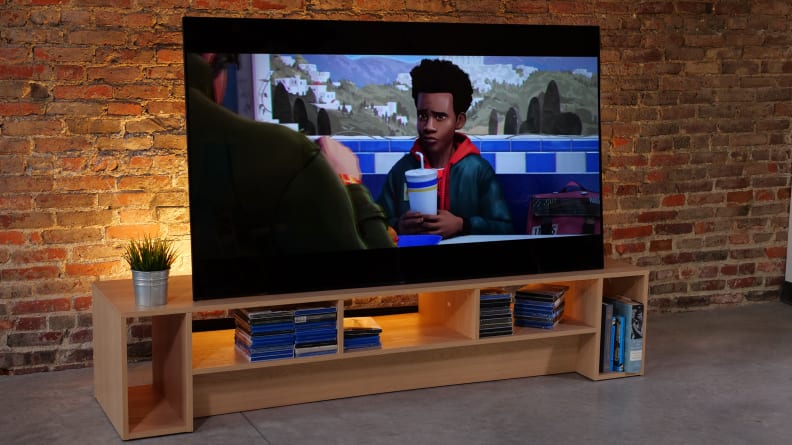
SDR content looks fantastic on the A9F thanks to near-perfect color and high contrast.
The A9F is all but impervious to off-angle viewing. It's obviously not ideal to get stuck watching a movie from the corner of the room, away from the TV, but if you had to get stuck in that unfortunate seat, there's no type of TV you'd rather be stuck watching.
My one viewing angle-related complaint with the A9F (other than its tilted panel) is the screen's glossy, reflective nature. From a contrast and color standpoint, the A9F doesn't suffer from a slightly-off angle, but if you happen to catch a window reflection in your eye line, it's gonna get in your way.
What We Don't Like
Its unique design straddles the line between contemporary and cumbersome
As much as the A9F's wildly inventive design wowed my coworkers and me, it's not without it's drawbacks.
If you're not planning on wall-mounting the A9F, it's going to need an extremely wide surface to rest upon. Unlike most TVs, whose surfaces need only to accommodate the width of a traditional base stand, the entire bottom bezel of the A9F will end up touching whatever surface it sits on—all 48 inches of it.
Additionally, setting up the A9F is a hefty chore, requiring at least two people to slot the weighted portion of the TV's back-facing stand into its counterpart piece.
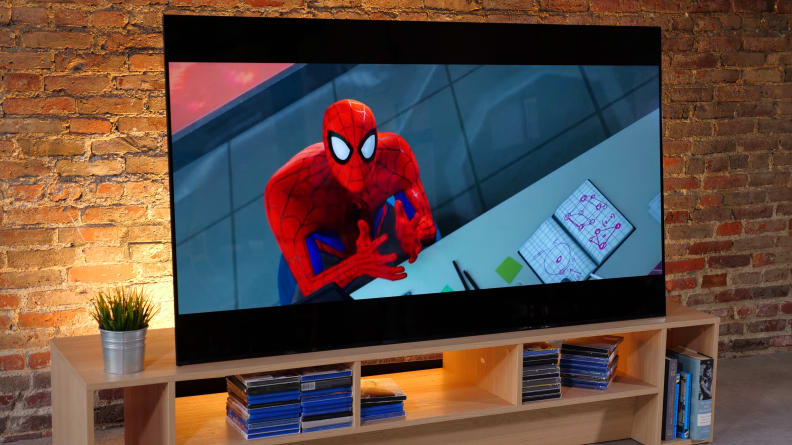
The A9F is a winning TV—as long as you don't mind a picture that tilts backwards slightly.
And then there's the slanted picture: I recommend sizing the A9F up in person before making any commitments. Most people's eyes will adjust to the A9F's slanted panel, but a quick poll of my colleagues suggest that it's not everyone's cup of tea.
The software is difficult to navigate and the controller is no better
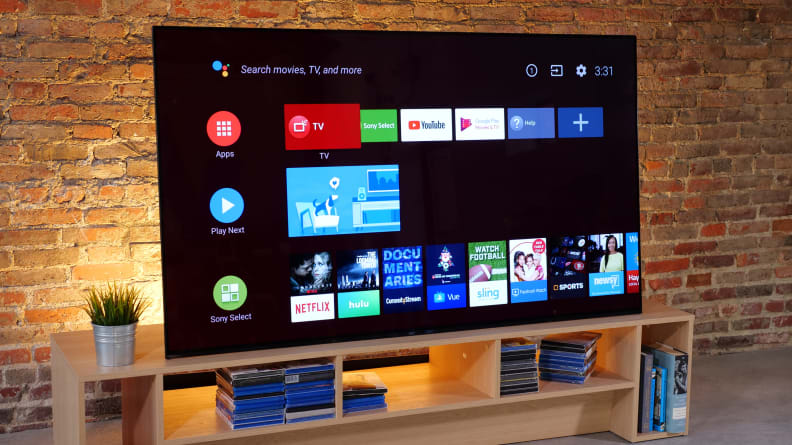
The A9F is equipped with an Android smart platform. For the most part, all of the expected apps and features are accounted for, but the software can be head-scratching.
Sony's Android-based smart platform offers a ton of flexibility (including Chromecast functionality, Google Play/Home/Assistant integration, and a host of supported apps), but the user interface feels like two or three altogether separate pieces of software laid on top of one another. There are multiple entry points for accessing certain settings and features, and certain information (like whether or not the input is displaying an HDR signal) is harder to access than it ought to be.
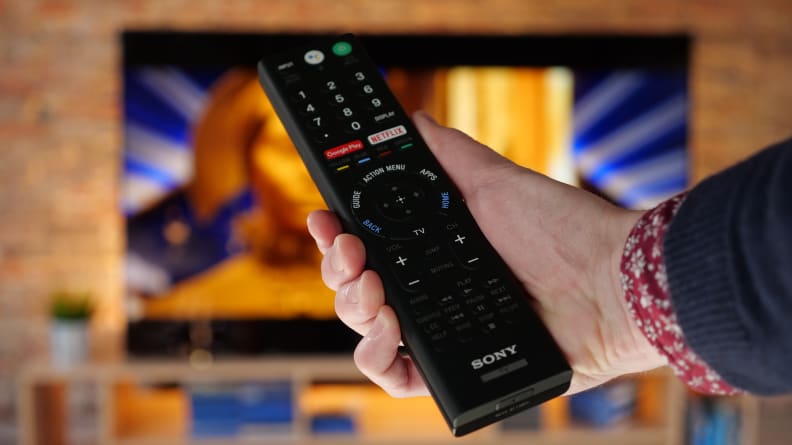
The Sony A9F's remote control is an old-school design with modern engineering. The entire face is rubberized and seamless, so crumbs and other debris won't find their way in between buttons. Still, the design is crowded, chunky, and tough to grow accustomed to.
The remote control is rather confounding, as well—it's simultaneously too utilitarian and too complicated. I appreciate the back-to-basics approach to a TV remote in 2019, but the A9F's old school remote is chunky, crowded with buttons, and confusingly labeled. I still, for example, have no idea why the most prominent menu button is labeled "Action Menu." What's even more peculiar is why pushing this button brings up a small box of submenus that are altogether unmoored from the rest of the TV's Android-based software.
In tandem, the software and the remote control create a barebones experience that feels industrial—like I'm using a TV built by and for engineers savvy enough to make the most of it, not a TV aimed at making things smooth and easy.
If LG's (admittedly flawed) smart TV system is a box of Legos, the Sony A9F is an Erector Set. You might be able to do more with it, but it's cold, hard steel all the way down.
The Verdict
The Sony A9F is a phenomenal TV, but it's not for everyone who happens to be shopping for a top-shelf HDR TV
With each new OLED TV that Sony engineers, it gets better at ironing out the wrinkles. The A9F's handful of flaws—the fussy design, the tilted panel, and its stripped-down, rigid software—are, in my mind, good ol' fashioned Sony-related issues.
I've always felt like Sony's TVs are cold, heavy machines with user interfaces designed for your geeky, audiophile aunt or uncle. The A9F Master Series is no different. But if you push these surface-level complaints to the side, the A9F is a near-perfect TV—one that demonstrates the unimpeachable superiority of OLED technology over pretty much every display not equipped with quantum dots.
To that end, if you're shopping for an ultra-premium, top-shelf TV and plan on sticking it in a bright room, you might want a QLED TV that packs a brighter punch, like the Samsung Q9FN or the relatively affordable Vizio Quantum P. Both of these TVs don't offer the inky-dark black levels of OLED displays, but they're two of the brightest HDR TVs money can buy right now, and they're both available in 65-inch models.
Additionally, if your heart is set on an OLED TV and all it has to offer, the LG C8 is not only our current highest-rated TV, but also one of the more value-packed OLED TVs LG currently sells. Plus, LG's webOS smart platform is far more user-friendly than the A9F's Android software.
Related Video: LG's latest OLED TV is smarter, faster, and looks incredible
Meet the tester
Michael Desjardin graduated from Emerson College after having studied media production and screenwriting. He specializes in tech for Reviewed, but also loves film criticism, weird ambient music, cooking, and food in general.
Checking our work.
Our team is here to help you buy the best stuff and love what you own. Our writers, editors, and experts obsess over the products we cover to make sure you're confident and satisfied. Have a different opinion about something we recommend? Email us and we'll compare notes.
Shoot us an email
